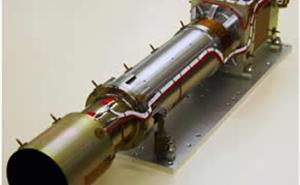RALCam-3

RALCam-3 is a satellite earth-observation camera, designed and built within the Space Science and Technology Department. The camera is a push-broom imager, meaning that a single line of detector pixels is swept along the ground by the motion of the satellite to build up a two dimensional image.
The resolution on the ground is between 10 and 12 metres depending on the operational altitude and the camera operates in four wavebands in the visible and near infrared, allowing colour images of the earth's surface to be built up.
RAL Space was responsible for the optical and mechanical design, the design and construction of the electronics, thermal design, assembly and test of the entire camera system as well as providing software for ground support and image analysis (see DIVA). The camera has a simple all-refractive optical design, well-matched to its resolution requirements without the complexity, mass and expense of a mirror system. Engineers within the Imaging Systems Division managed the project and undertook the overall system design of the camera, including the definition of the top-level specification, optical design and electronic architecture.
The optical design of the camera was carried out within the Optical Systems Group. Using in-house models the camera radiometric flux budget was established, enabling the camera aperture size to be determined, and stray light analysis was carried out to ensure that the camera would not be affected by glare from bright out-of-field objects, such as the Sun. The camera’s lens system was designed using radiation stabilised glasses, meaning that it is not vulnerable to the changes in transmission which can afflict standard optical glasses in the space radiation environment.
The camera electronics were designed within the electronics group. The industry standard SpaceWire protocol is used for commanding and image download and a fully specified user interface allows programming of the camera to select parameters such as exposure time and image size. The camera contains an 8000 element linear CCD plus all of the electronics necessary to drive the detector and read out the image.
The optical quality of the assembled camera was checked in the Optical Systems Group’s dedicated optical test laboratory before environmental test in air and vacuum using the department’s mechanical and thermal-vacuum test facilities.
The first RALCam-3 was developed for a commercial customer and a second model is now being built for use on Amazonia-1 the Brazilian National Institute for Space Research's new satellite which will monitor the Brazilian rainforest, where several thousand square kilometres of forest continue to disappear each year. The camera will produce images of terrain in 100km sections and at 12 metre resolution, and these pictures will be used to identify areas of illegal logging. The UK's Department for International Development (DFID) are supporting the camera build from a fund set up to help preserve the Congo Basin rainforest - one of the other areas that the camera will be able to study, along with the Brazilian Amazon. Amazonia-1 is due for launch in 2012.
FMOS (Fibre Multi Object Spectrograph)
FMOS (Fibre Multi Object Spectrograph) is a spectrograph used in astronomy to measure the infra-red spectra from 400 celestial objects simultaneously and takes advantage of the large 30' field of view of the 8.2m Subaru telescope in Hawaii. RAL Space played a leading role in its design and development within the collaboration between the UK, JAXA (the Japanese Space Agency) and AAO (the Anglo-Australian Observatory).

FMOS camera being tested
The optical design shows the key components of the large collimator mirror, diffraction grating gratings and the cryogenic camera, which was built within the Imaging Systems division. The camera contains some of the largest fused silica lenses used temperatures as low as 70K where the mount design was critical in protecting the lenses and maintaining their alignment. Figure 2 shows the camera being tested with our 4d-Phasecam vibration insensitive interferometer.
